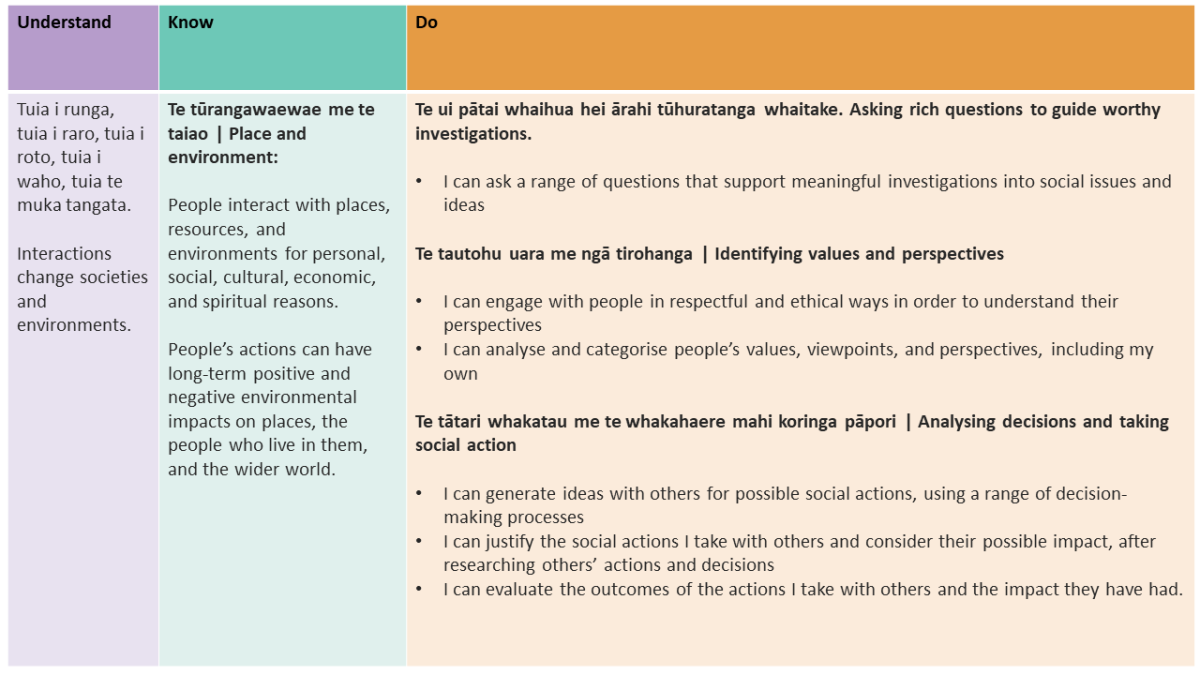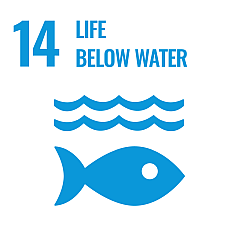<- Tamatea field trip homepage
Curriculum highlights
This virtual field trip aligns with Te Mātaiaho, the refreshed New Zealand Curriculum. It is designed to integrate key learning areas and priorities by offering a rich educational experience in biodiversity, conservation, social sciences, and science.
Curriculum flexibility
Our field trips include cross-curricular learning experiences which can be adapted to different learning areas and progressions. You can develop your teaching approach to suit ākonga interests and needs.
Te ao Tūroa | Science
Explore marine and forest ecosystems, biodiversity, predator and pest removal, and the impact of human activity on fragile environments. Foster scientific inquiry and analysis skills.
For example: The Environmental guardianship in Tamatea Dusky Sound virtual field trip can effectively support learning outcomes in the strands Nature of Science and Living World, and Planet Earth and Beyond, (predominantly in years 4-8) of the 2007 New Zealand Science learning area.
- Understanding ecosystems: The field trip allows ākonga to explore marine and forest ecosystems in Tamatea Dusky Sound. Ākonga will gain an understanding of the complex interactions between living organisms and their environment.
- Biodiversity conservation: Ākonga can learn about biodiversity and the importance of conservation. They will understand how biodiversity is essential for ecosystem health and stability.
- Scientific inquiry skills: The field trip can foster scientific inquiry and analysis skills. Ākonga can develop their ability to ask questions, collect data, and make observations in their local environment.
Te ao Tangata | Social sciences
Examine the societal aspects of biodiversity conservation, including the role of organisations such as the Department of Conservation, local iwi, environmentalists, and business owners in land and sea management. Encourage ākonga to explore social and cultural dimensions of environmental stewardship.
For example: The Environmental guardianship in Tamatea Dusky Sound virtual field trip can effectively support the progress outcomes in Phase 2 (Years 4-6) of the refreshed New Zealand Social Sciences learning area, specifically in terms of the Understand, Know, and Do (UKD) framework.

NELP Priorities
This field trip aligns with National Education Learning Priorities (NELP) by promoting ākonga-led learning, highlighting community collaboration and cultural values. It promotes active citizenship through environmental responsibility, and encourages community engagement, preparing ākonga for the challenges of the future.
Sustainable Development Goals (SDGs)
The UNESCO Resources for Educators - Life Below Water (Goal 14) offers a range of educational materials and tools designed to enhance ocean awareness and sustainable resource exploitation.
![]()
The UNESCO Resources for Educators - Life on Land (Goal 15) offers a range of educational materials and tools designed to enhance awareness of biodiversity and ecosystems.
Reflective teacher questions
Use the following reflective questions to guide your teaching practice:
- How can I best support ākonga in understanding the complex marine and forest ecosystems of Tamatea Dusky Sound from both scientific and social perspectives?
- What strategies can I employ to encourage critical thinking, problem-solving, and effective communication about local biodiversity conservation?
- How can I foster an inquiry-based approach that empowers ākonga to investigate biodiversity changes, social implications, and historical influences on conservation efforts?
- In what ways can I help ākonga understand the impact of human activity on fragile environments?
A suggested teaching and learning framework
The following suggested approach supports learning progressions in social sciences and aligns with the Understand, Know, Do (UKD) framework, and current learning outcomes in science, by fostering understanding, knowledge, critical thinking, and independent inquiry.
1. Introduce and explore
Begin by introducing the field trip's objective, emphasising the importance of biodiversity restoration in Tamatea Dusky Sound.
![]() Evaluate prior learning
Evaluate prior learning
Use the pre-trip survey (downloadable Word document) to assess ākonga understanding about concepts around biodiversity, interconnected ecosystems and conservation, and stimulate interest in the trip. Copy and paste the questions and answers into an interactive platform like Kahoot!, Google Forms, or Quizlet for this activity.
Dive into the virtual field trip's resources, including videos, images, and GIS maps. Encourage ākonga to explore the unique ecosystems, biodiversity and conservation in the region.
- Ākonga can use Videos - Play & think (downloadable PDF) to take notes during each video to help them remember key points and examples. Hold a group discussion to share findings and discuss the impact of the video on their understanding.
2. Extend learning
Engage ākonga in learning activities that promote discussion and a deeper understanding of concepts such as biodiversity, ecosystems and conservation efforts. Use the Field trip activities (downloadable PDF) to support this approach.
![]() Evaluate ākonga learning
Evaluate ākonga learning
Assess readiness and stimulate thinking toward any upcoming conservation-based, student-led inquiry.
- Use the post-trip survey (downloadable Word document) to measure the progress and depth of ākonga learning concerning Tamatea Dusky Sound, biodiversity conservation, cultural heritage, and their capacity to apply this knowledge to practical actions in their own communities. Additionally, these questions will stimulate their thinking about any upcoming conservation-based, student-led inquiry. Copy and paste the questions and answers into a platform like Google Forms or Survey Monkey for this activity.
- Use this Solo taxonomy rubric (downloadable Word document) to assess ākonga understanding of ecosystems, biodiversity, and conservation, emphasising their comprehension of ecosystem interconnectivity.
3. Enable ākonga-led inquiry
Empower ākonga to independently or collaboratively conceive, execute, and oversee their own conservation initiatives with a specific emphasis on protecting connected ecosystems in Aotearoa.
Prompt ākonga to generate open-ended questions or challenges relevant to local biodiversity conservation and restoration, while considering historical and societal and cultural factors. E.g.
- Biodiversity: Why is it important to have a variety of different species in an ecosystem, and how does this diversity help keep the environment strong and balanced?
- Conservation: What actions can people take to ensure the long-term survival of endangered species in their natural habitats?
- Ecosystems: How do changes in one part of an ecosystem affect the rest of the ecosystem?
- Historical: What significant events or actions in the past have had an impact on the biodiversity of a particular ecosystem?
- Cultural: How do the beliefs, traditions, and mātauranga of local iwi influence how people care for the environment?
- Societal: How do the choices people make, like construction or using natural resources, affect ecosystems and biodiversity?
Encourage ākonga to explore topics, seek information, connect with experts, and gather data for inquiries related to a biodiversity, ecosystems, sustainability and conservation.
4. Present and share
Assist ākonga to present and share their learning. This could include, but is not limited to, digital storytelling, websites, podcasts, exhibitions, video, community engagement.
![]() Evaluate ākonga learning
Evaluate ākonga learning
Assess student-led inquiry, critical thinking and problem solving using this Solo taxonomy rubric (downloadable Word document) as a guide.
5. Reflect
After completing their inquiries and sharing their findings, encourage ākonga to reflect on what they've learned. Ask them to think about how their understanding of biodiversity, ecosystems, and conservation has evolved and what this means for their decision-making and actions.
Links
- Pure Salt - Conservation
Pure Salt has a vision for Dusky Sound to be one of the most intact ecosystems on Earth, and New Zealand's largest ‘biobank’ – a source of endangered native species that can be sent to pest free locations throughout the country. - Video experiences in Fiordland
Short video clips from New Zealand Geographic featuring a selecgtion of Fiordland experiences. - Our Big Blue Back Yard - Fiordland
A 45 minute NZNH documentary on the natural features of Fiordland. - Story: Kaitiakitanga – guardianship and conservation
From Te Ara: Encyclopedia of New Zealand. - Department of Conservation (DOC) - Biodiversity:Nature
Explore DOC's resources on biodiversity and conservation efforts in New Zealand, considering both scientific and societal dimensions. - Tamatea/Dusky Sound restoration project (DOC)
Learn about ongoing conservation projects and initiatives in Tamatea Dusky Sound, including historical and societal context. - Predator Free NZ - Kids and schools
An introduction to where to begin and how to get the kids excited and proactive about conservation. - Schools toolkit
A rich assortment of conservation learning resources from Predator Free NZ. - Ministry for the environment - educational resources
Educational resources to help students, teachers and communities contribute to the future wellbeing of the environment. - Forest and Bird
The Royal Forest and Bird Protection Society of New Zealand is New Zealand's largest national conservation organisation




